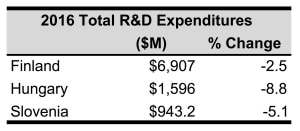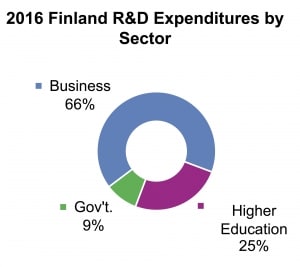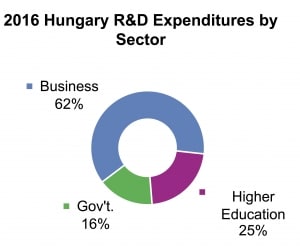R&D Expenditures Drop in Three EU Countries
The countries of Finland, Hungary and Slovenia recently released preliminary figures on 2016 total R&D expenditures, and data indicated that spending for research declined in all three nations.
Although the European countries represent three different levels of R&D output and scientific innovation, the decline in total 2016 R&D spending shared by Finland, Hungary and Slovenia suggest that the trend of higher business R&D expenditures in all countries is unable to offset the slowing R&D spending of the countries’ governments.
Finland, a research-intensive powerhouse, has traditionally been amongst the Nordic countries that spend the largest share of GDP on R&D, according to the UNESCO Institute for Statistics. Hungary has been steadily increasing its R&D spending since the mid-1990s, but according to the European Commission, growth plateaued in 2002, and has since staggered upwards. Slovenia, one of the fastest growing European countries for innovation and research spending, has the highest GDP per capita in regards to innovation indicators in Central and Eastern Europe, as defined by the Organization for Economic Cooperation and Development .
Finland
In Finland, 2016 R&D expenditures were €5.9 billion ($6.9 billion = €0.85 = $1) in 2016, a 2.5% decrease. The business sector in Finland was largely responsible for the decline, as R&D spending fell nearly 4% in the sector. In the higher education and government sectors, 2016 R&D expenditures were nearly equal to the year prior. Preliminary data suggests that R&D expenditure will increase by €100 million ($116.6 million) in 2017, with business enterprises’ spending recovering.
In total, 72,400 researchers were working in Finland in 2016, with around 50% in the business sector, a 5.0% decrease. Approximately 74% of R&D staff were researchers and R&D engineers, with the remaining staff serving as support or other research personnel. In the business sector, although 58% of R&D staff worked full time, overall R&D staffing decreased by 600 people.
As a percentage of the nation’s GDP, R&D expenditures made up 2.8% in 2016, continuing the downwards trend that began in 2009 when R&D spending made up 3.8%. In 2017, R&D expenditure is forecast to account for 2.7% of GDP.
Business Sector
Finnish R&D expenditures in the business sector were €3.9 billion ($4.5 billion), a 3.6% decrease, and accounted for 66% of total R&D expenditures and 55% of funding expenditures. Out of this, €3.2 billion ($3.7 billion) was spent by domestic enterprises, while foreign funding totaled €483.8 million ($563.9 million), a decline of 1.1% and 28.3%, respectively.
Extramural research is defined by Statistics Finland as “entire R&D projects or undertakings contracted out by the enterprise or organization, which are not service purchases of own R&D activities or support functions.” This R&D expenditure is estimated to total €370 million ($431.2 million) in 2016. Fifty-four percent of extramural research was accounted for by the Finnish business sector, totaling €200 million ($233.1 million).
Business enterprise funding in 2017 is estimated to increase to approximately €4 billion ($4.7 billion), representing 66% of total R&D expenditures, with €100 million ($116.6 million) coming from foreign sources.
Higher Education
Expenditures on R&D in higher education increased 0.6% in 2016, amounting to €1.5 billion ($1.7 billion). But public funding slightly declined to €1,202.0 ($1.4 billion), a 1.4% decrease, while the number of grants decreased 5.0% to €112.8 million ($131.5 million). Regionally, 40% of R&D was carried out in Uusimaa, 12% in Varsinais-Suomi and Pirkanmaa, and 9% in North Ostrobothnia.
As a share of total R&D expenditures, higher education represented 25% of spending. In the higher education sector, research is infrequently outsourced, but research services conducted by the higher education sector amounted to €35 million ($40.8 million).
Government
Government spending on R&D totaled €554.2 million ($646.0 million) in 2016, down 1.6%. R&D expenditures of state administrative branches also decreased, amounting to €333.6 million ($388.8 million), a 4.3% decline. Foreign funding, however, increased 8.2% to €85.8 million ($100.0 million).
Although the government made up 9% of total R&D expenditures, its share in funding was 33%, which includes basic funding of higher education as per the Ministry of Education and Culture. Regionally, 64% of government R&D was performed in Uusimaa.
Hungary
More than HUF 427 billion ($1.6 billion = HUF 265.7 = $1), or 1.22% of GDP, went towards R&D expenditures in 2016 in Hungary, an 8.8% decrease at current prices. Spending fell 7.9% both in the business sector and at R&D institutes and other budgetary units, and fell 16.1% in the higher education sector.
Foreign R&D sources contributed approximately HUF 71 billion ($265.3 million), a 1.2% increase, while the amount of R&D funding from the government and nonprofit sectors declined. Federal R&D capital expenditures dropped 21.2% to HUF 49,163 million ($183.7 thousand), while the government’s share of R&D spending declined 9.3% to represent 12% of total R&D expenditures in 2016.
Business Sector
HUF 316.7 billion ($1.2 billion) was spent on R&D activities by business enterprises in 2016, a 7.9% decrease. However, R&D expenditures funded by the business sector increased 3.5%, with its share in spending rising 13.5% to represent 56% of total R&D expenditures. However, this rise in business sector funding was unable to offset the decrease in business R&D spending. Generally, the number of research units within the business sector are steadily on the rise, while in contrast, the higher education and government sectors are slowly declining. Last year, 1,291 business enterprises had functioning R&D units in Hungary, an 8.6% drop.
The number of employees conducting R&D activities in companies fell 1.5% to 23,349, with the number of researcher staff growing 1.5%, but the number of technical staff falling 5.3%. Over 58.2% of all full-time R&D staff were employed at R&D units at business enterprises in 2016 out of a total of 20,825 full-time staff, a 1.0% decline.
The proportion of R&D capital expenditure, within the total R&D expenditure, was HUF 41 billion ($153.2 million), or 13%. Almost 50% of total business R&D expenditures were spent on manufacturing, including the manufacture of pharmaceutical products, which accounted for 36%, with the amount of R&D spent on basic pharmaceutical products increasing almost 1.5 times.
Higher Education
In 2016, total R&D expenditure in Hungary’s higher education sector dropped 16.1% to HUF 47.6 billion ($177.8 million). Almost 93%, or HUF 44 billion ($164.4 million), of total R&D expenditures was used for current R&D costs, with 75% of these costs for personnel purposes. R&D capital expenditures totaled HUF 3.6 billion ($13.5 million), with nearly 75% spent on equipment, 22% on land and buildings, and 3% on software.
There were 1,311 R&D units within the higher education sector, with the proportion of all research units within this sector rising to 48%. Out of these units, 21,969 personnel worked on R&D activities, with virtually no changes in staff numbers in 2016. Within R&D personnel, the number of researchers increased 2.5%, while the number of technicians and support staff fell 5.2% and 8.0%, respectively. As with previous years, the number of full-time staff performing scientific research at universities decreased to 5,592.
Almost 69% of higher education R&D funding came from the government, and around 10% from the business sector. Fifteen percent of R&D funding for higher education came from foreign sources, and nonprofit organizations funded the remaining 6%.
The fields of natural science, medical and health sciences, and agricultural sciences spent HUF 44.7 million ($167.0 thousand), HUF 45.8 million ($171.1 thousand) and HUF 32.5 million ($121.4 thousand) on R&D, respectively, in 2016.
Government Sector
Over HUF 57 billion ($213.0 million) was spent on government R&D in 2016, an 8.0% decrease. Current costs comprised 14% of total federal R&D expenditure, while capital expenditure accounted for 9.5%. Approximately 82% of R&D spending came from federal sources, with 12% coming internationally.
Federal R&D units comprised almost 5% of the total number of research units in Hungary, dropping by 10 units in 2016. Total R&D personnel in government were 9,318, including 7,456 full-time staff, a decrease of 11.0% and 8.0%, respectively, with the main factor for the decline being the drop in the number of technicians at research institutes.
The vast majority, or 55%, of R&D expenditures were in the natural sciences with an additional budget of HUF 1 billion ($3.7 million); however, only 33% of natural sciences R&D expenditures were spent by the government, as 57% was expended by the business sector. Agricultural research spending also increased 1% in 2016, accounting for 11% of total government R&D expenditures.
Slovenia
R&D expenditures in Slovenia were 2.0% of GDP in 2016, totaling €809.2 million ($943.2 million), a 5.1% drop.
September data indicated that government budget allocations for R&D increased 1.8% to €162.8 million ($189.8 million), or 0.40% as a share of Slovenia’s GDP. Approximately 91% of government allocations were spent in the government and higher education sectors, while 8% was expended in the business sector, and foreign and nonprofit sectors received the remaining 1%.
Socioeconomic objectives for the country that received the most budget allocations were General Progress of Knowledge, Industrial Production and Technology, and Health, receiving €91.8 million ($107.0 million), €16.2 million ($18.9 million) and €15.1 million ($17.6 million), respectively, with the same priorities predicted for 2017. The planned government budget allocations for R&D for 2017 total €172.3 million ($200.8 million), signaling a 5.5% increase.
After 2013, R&D expenditure began a downward trend in Slovenia, which has continued into 2016. R&D staff numbers have declined 3.2% to 19,975, with 56% of staff working as researchers in 2016.
Expenditures by Sector
In the business sector, Slovenian R&D expenditures decreased 5.2% to €559.3 million ($651.9 million) and accounted for 69% of total funding. As a share of GDP, business R&D expenditures comprised 1.69%. R&D expenditures by higher education, however, jumped 9.7% in 2016. Higher education comprised 0.3% of total funding and made up 0.23% of the country’s GDP.
In 2016, government R&D expenditures nominally declined 3.3% to €164.0 million ($191.2 million) and comprised 13% of total funding. R&D expenditure in this sector had a 0.30% share of GDP. Foreign R&D expenditure also declined 8.3% to €82.6 million ($96.3 million), while private nonprofit R&D expenditures contracted 30.3% to €46 million ($53.6 million).




